We have all experienced this, scanning the internet when all of the sudden we spot “the deal of the century.” A Fender blackguard Telecaster for $400? Yes, please!
You study the blurry online pictures and it looks to be the real deal. Maple neck? Check. Black pickguard? Check. Chrome control plate? Check. It looks good; it has to be real, right?
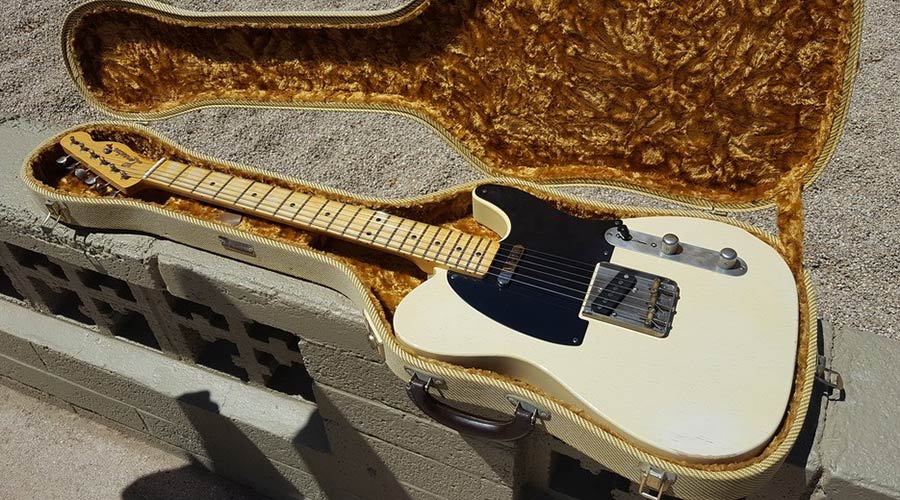
You hurry across town to pick up your new acquisition before someone beats you to it. Your hands are shaking in anticipation; you quickly hand over the cash in exchange for the new axe, and you rush back to your car before the seller can change their mind.
You speed home, ready to rock, only to notice a few inconsistencies with your new guitar. The neck just doesn’t feel as chunky as a vintage neck should feel. The pickups seem a little weak, and you notice the bridge plate doesn’t have a Fender stamp on it. All of a sudden, the dreaded feeling sinks in, “did I just get ripped off?”
Got G.A.S.?
As a guitarist myself, I am not immune to sudden bouts of G.A.S. (guitar (or gear) acquisition syndrome). Nothing makes me tingle all over like a great deal, but sometimes those deals don’t turn out as we would hope.
So how can you tell whether a Telecaster is the real deal or not?
First, you know the saying: if the deal is too good to be true, it probably is. Fakers can take a Squier or some other import guitar that they bought for less than a C note and turn it into a fake Fender, tripling or even quadrupling their money on an unsuspecting victim.
What if it looks like a real Telecaster? How can I tell if I am finding the “Holy Grail” or the “Unholy Fail”?
So Many “Fake” Options
With multiple variations of Fender’s iconic Telecaster, the Affinity, the Sonic, the Bullet, the Classic Vibe, the Contemporary, and the Limited Edition, there are so many options available for the knowledgeable guitarist. Of course, we all know those are Squier options, so why are we discussing Squiers and not real Fender guitars?
Because for less than $20, you can buy a Fender decal off Etsy. A little nail polish remover and that Squier logo will be gone and replaced with your fake Etsy Fender logo, and you can sell that Squier for double what it’s actually worth.
So, how do we check to make sure we don’t get suckered on our next guitar purchase?
I Like Big Bodies; I Cannot Lie
The iconic Telecaster body shape is easily recognizable, but how do you know if it is a Fender body, a Squier body, or some other monstrosity repurposed from another brand? The first thing to look for is the actual thickness of the body itself. Most import and off-brand Telecasters will have a thinner body than a Fender Telecaster.
Leo Fender was a manufacturer who squeezed every ounce of profit he could from his creation. His Telecaster bodies typically measured around 1.75” (44.45MM) thick once they were finished. I know that seems like a weird thickness for a guitar body. Why not go a full 2” (50.8MM) in thickness or even a 1 ½” (38.1MM) just to keep it simple?
Raw wood products are sold in what I like to call quarter sizes. 4/4 lumber which should be 1” thick is not actually 1” thick. The board starts out at 1” in rough thickness, but once it is surfaced into usable lumber, the board ends up closer to .75” thick.
The same is true with 6/4 and 8/4 raw lumber. If Leo had purchased 6/4 lumber, his body thickness would have been somewhere around the 1.25” (31.75MM) thickness which will not work with a 1.25” tall pickup selector switch. Since the tele control cavity has to be 1.5” deep (38.1MM), Leo was forced to work with 8/4 lumber, which amounted to a Fender Telecaster body being roughly 1.75” (44.45MM) thick when all of the machining was complete.
The import market was able to work with a redesigned switch that was shorter. This allowed the manufacturers to thin down their bodies to 1.625” (41.275MM) and, in some cases, even thinner. Most Squier’s and import models will sport a 1.5625” to 1.625” (39.6875-41.275MM) finished body thickness. If the guitar body you are purchasing feels a bit thin, then it might not be a real Fender Telecaster.
Pop That Hood
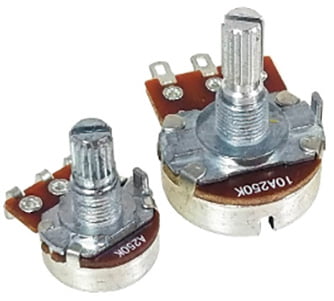
Mini pot on left, full size pot on right
Another way to check if your Fender Telecaster is authentic is to look under the hood. Once you lift that pickguard or pull the control plate, all your misgivings and worries will either be washed away or harshly confirmed.
Imposter Telecasters exist for one reason: to make their manufacturer the most amount of money possible, and there is no better place to skimp on costs than the pots (potentiometers for you educated individuals), switches and the pickups of a guitar. The easiest parts to check are those under the control plate, two screws removed and presto, you have access.
A real Fender Telecaster will sport full-size pots (potentiometers) which are easy to identify. A full-size pot is roughly the diameter of a US quarter, whereas a mini pot, which are used in a majority of import guitars, looks closer to the size of a dime. There are ongoing discussions as to how the size of the pots affects tone, but for our article, we are only focusing on “real” or “fake” Fender Telecasters. Dime-sized pots are a dead giveaway in spotting an imposter.
Pickups Rock and Roll, But Some Do It Better
The main item that affects the overall cost of a guitar is the pickups. Many imposter telecasters will have ceramic pickups because the cost to manufacture these pickups is significantly cheaper than producing Alnico pickups.
The difference between ceramic pickups and Alnico pickups is drastic, and they do affect tone. Alnico pickups consist of a set of magnetic slugs that are seated into a bobbin and then wrapped in copper wire. Each magnetic slug is independent of the others, and together, they create a magnetic field that transfers the string vibration into an audible tone.
Ceramic pickups are constructed roughly the same, other than the individual slugs are not magnetized. They utilize a single bar magnet that sits across the bottom of the bobbin to magnetize the slugs. I have heard fine sounding ceramic pickups, but if you look at the bottom of your newly acquired Telecaster and see a magnetic bar across the bottom of the pickup, it is probably a fake.
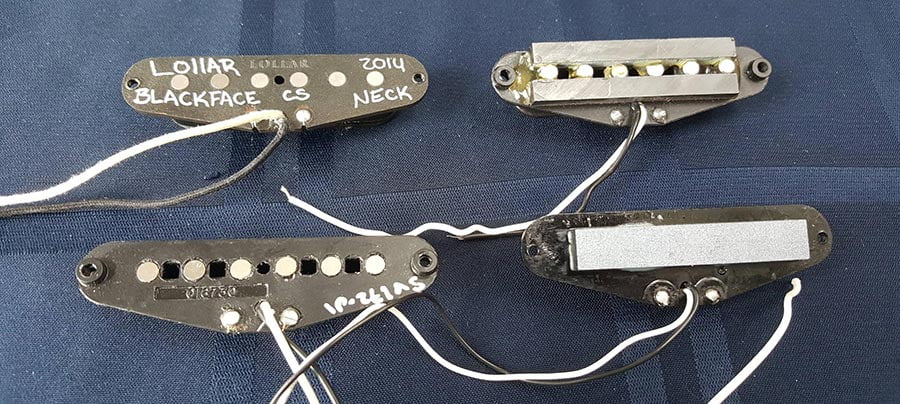
Alnico pickups on the left, Ceramic pickups on the right
I am not opposed to ceramic pickups. I actually have one (an “othercaster”) that boasts ceramic pickups that plays like a dream, but when you are buying a guitar that is supposed to have Alnico pickups, and it doesn’t, you have made an expensive mistake.
Some resellers will even pull and sell the original Alnico pickups for about half the value of the guitar. They will then install some cheap ceramics pickups and sell the guitar for less than full price, making you think you got a deal on a real Telecaster. Don’t fall for the bait and switch and check those pickups.
Holes, Holes and More Holes
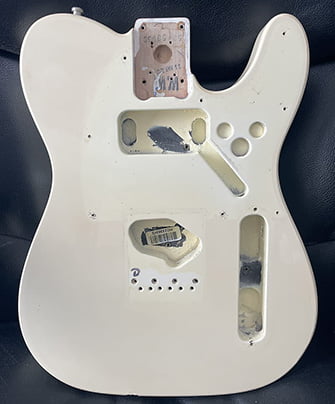
CNC milling holes on a Telecaster body
The other items you can look for under the pickguard are the CNC template milling marks on the body. Here’s an example of what a real Telecaster body should look like. Look at the area just under the neck pickup and above the control plate. These “smuggler holes,” “crop circles,” “mickey mouse ears,” and “dime and nickel storage holes” will give you a good indication of which factory made the body in question.
Some of you are probably thinking, “I have to take the guitar apart to see if it is a fake or not? That seems like a lot of work”. Hold on, my friend. There are a few things you can look for without breaking out the screwdriver to verify authenticity.
Check the Obvious
Let’s take a look at the neck of the guitar. The neck holds a plethora of information for those who are willing to do a little research. The first thing to look at is the serial number. Fender has their serial numbers in a database that you can look up online. The number will not only reference the year in which the guitar was manufactured, but it will also list out the specifications of the guitar. If a guitar doesn’t have a serial number, you should be on your guard.
There are “fakers” who will use a serial number from another guitar on a fake; but they usually don’t get all the information correct. If you find a black guard Telecaster for sale and run the serial number, and the Fender site tells you it is an “American Performer Stratocaster with a sunburst body and a rosewood neck,” well then you have just found a fake.
A Telecaster by Any Other Name, is Not Always a Telecaster
Also, be aware of the logo on the headstock. There are plenty of fake ones in the wild. Pay close attention to the location of the logo in relation to the tuners and the edge of the headstock. Many fakers make the mistake of installing the logo too far up the headstock, crooked to the edge of the headstock, or using the wrong logo style for the era of the guitar in question. Use Fender’s website to look at the model in question and study how that logo appears on the headstock. Fender is really consistent with placement of their logos; the fakers not so much.
Waterslide decals are cheap and easy to make, so don’t take a Fender logo at face value. A fake logo is installed a lot of times directly on top of the top coat. Looking at the logo under a bright light or in the sun will show the outline of the entire decal, whereas a real Telecaster will have the decal buried under layers of the top coat obscuring the edges of the waterslide decal.
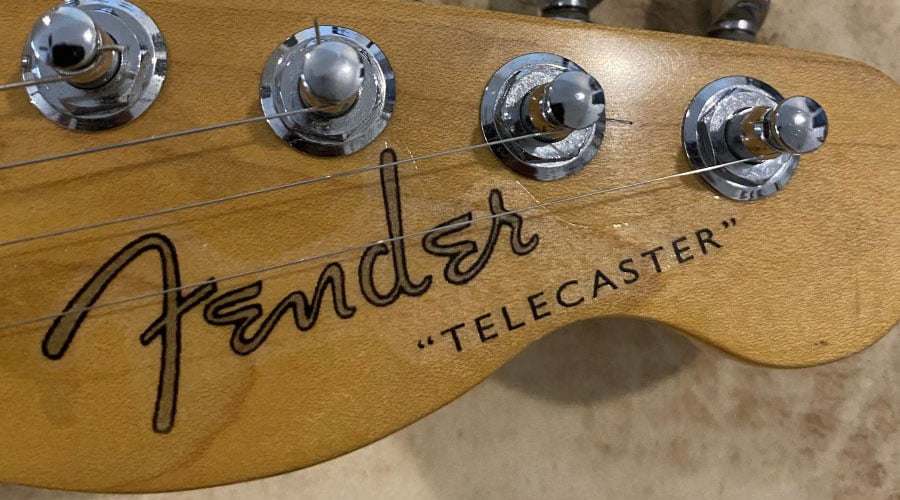
Zoom in and notice the fake Fender waterslide decal
Also, take a look at the back of the headstock. Some fakers will replace the front headstock logo and forget the “Made in China” notation on the back of the headstock. I have even seen a few guitars where the faker just scratched out the serial number and the country of origin from the back of the headstock, avoid these monstrosities like the plague.
You Can Tune a Guitar, But You Can’t Tuna Fish
While we are looking at the back of the headstock, take a look at the tuners. Some fakers will replace the cheap tuners with a nicer set of tuners or vice versa, and many times the screw holes won’t line up. Extra holes drilled into the back of the headstock should be a red flag that some modifications have been made to the guitar. Check to make sure the tuners match the make and model.
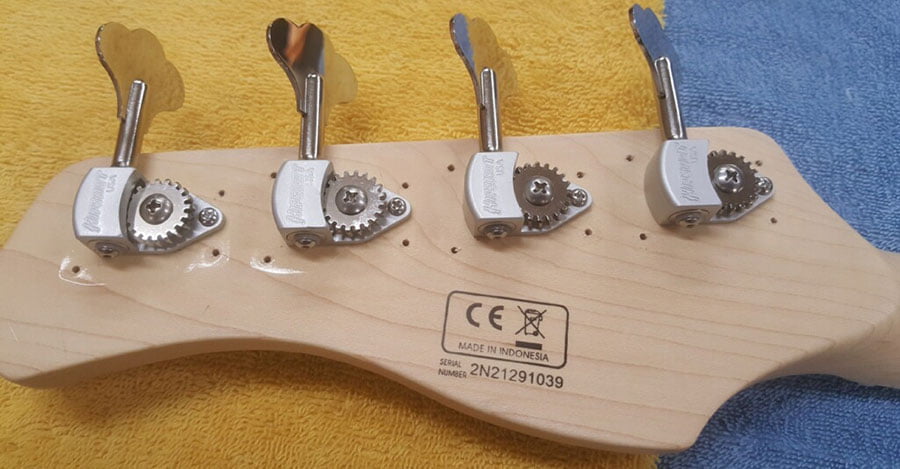
Extra tuner holes don’t always make it better
Also, pay attention to the shape of the headstock front and back. The Telecaster headstock shape is iconic, and if it looks a little off to your eye, then it probably is.
Take a look at the nut; real telecasters will have a bone nut, while the imports will have a cheap plastic nut. If you look closely, you can often see the cast marks on a plastic nut, which should be a sign that someone is trying to sell you a fake.
The truss rod hole is another item I like to look at on the Fender site to ensure the neck in question is legit. The lack of a plastic or walnut sleeve around the truss rod usually indicates a cheap import neck. American Fender necks normally will sport a walnut truss rod plug, and MIM (Made in Mexico) necks and some Squiers will sport a plastic sleeve around the truss rod opening. If you want to get really detailed, take a set of metric and standard Allen wrenches with you to inspect the guitar. Standard Allen wrenches fit most US-made guitar truss rods; their metrics are used in most everything else.
So, before you hand over that wad of cash for that new Telecaster, do a little research and save yourself the trouble of bringing home a Telefaker, a Chinacaster, or a Fernden Telecaser.
Frequently Asked Questions
How can you tell is a Fender Telecaster is real?
The best thing to check is the serial number. Although serial numbers can be faked, most fakers can’t replicate a serial number that will list the correct specifications of the guitar.
Do all Fender Telecasters have a serial number?
Yes, all genuine Fender Telecasters have a serial number. Any guitar that does not have a serial number needs to be highly suspect.
How do you know if a Fender is American made?
Usually the logo will have a “Made in U.S.A.” added to it although this can be faked sometimes. Some older guitars will have the serial number stamped on the neck plate or the bridge itself. Check the Fender serial number website to authenticate manufacturer date and location of the fabrication facility.
Share your thoughts in our forum! 💬
👉 Introduce yourself and show off your Telecaster and other gear.
Share this post with your friends using these one-click sharing options:
👉 Click here to share on Facebook.
👉 Click here to share on X.
👉 Click here to share on LinkedIn.
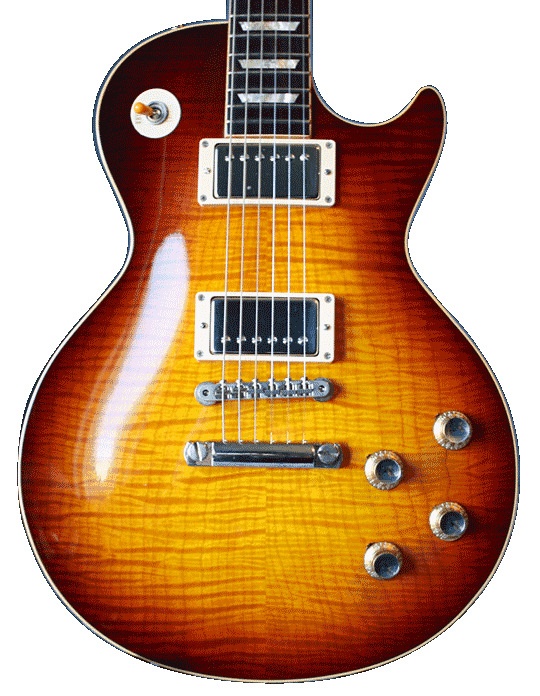
Get the latest reviews, guides and videos in your inbox.